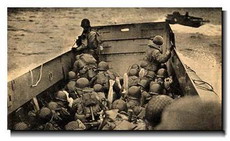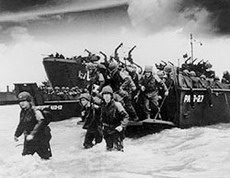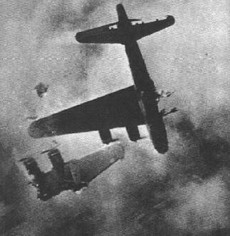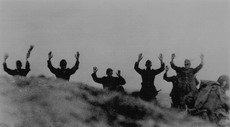Military
 Friday - July 01, 2005
Friday - July 01, 2005
Broadside
I received this from an anonymous source (hey, if Dan Rather can get away with it then so can I) who is deeply embedded in the Department Of Defense. I cannot reveal the source, other than to say the person is a retired Navy Chief who has an interesting observation ....
America’s military can win wars. We’ve done it in the past, and I have absolute confidence that we’ll continue to do it in the future. We’ve won fights in which we possessed overwhelming technological superiority (Desert Storm), as well as conflicts in which we were the technical underdogs (the American Revolution). We’ve crossed swords with numerically superior foes, and with militaries a fraction of the size of our own. We’ve battled on our own soil, and on the soil of foreign lands—on the sea, under the sea, and in the skies. We’ve even engaged in a bit of cyber-combat, way out there on the electronic frontier. At one time or another, we’ve done battle under just about every circumstance imaginable, armed with everything from muskets to cruise missiles. And, somehow, we’ve managed to do it all with the wrong Army.
That’s right, America has the wrong Army. I don’t know how it happened, but it did. We have the wrong Army. It’s too small; it’s not deployed properly; it’s inadequately trained, and it doesn’t have the right sort of logistical support. It’s a shambles. I have no idea how those guys even manage to fight.
Now, before my brothers and sisters of the OD green persuasion get their fur up, I have another revelation for you. We also have the wrong Navy. And if you want to get down to brass tacks, we’ve got the wrong Air Force, the wrong Marine Corps, and the wrong Coast Guard.
Don’t believe me? Pick up a newspaper or turn on your television. In the past week, I’ve watched or read at least a dozen commentaries on the strength, size, and deployment of our military forces. All of our uniform services get called on the carpet for different reasons, but our critics unanimously agree that we’re doing pretty much everything wrong.
I think it’s sort of a game. The critics won’t tell you what the game is called, so I’ve taken the liberty of naming it myself. I call it the ‘No Right Answer’ game. It’s easy to play, and it must be a lot of fun because politicos and journalists can’t stop playing it.
I’ll teach you the rules. Here’s Rule #1: No matter how the U.S. military is organized, it’s the wrong force. Actually, that’s the only rule in this game. We don’t really need any other rules, because that one applies in all possible situations. Allow me to demonstrate…
If the Air Force’s fighter jets are showing their age, critics will tell us that Air Force leaders are mismanaging their assets, and endangering the safety of their personnel. If the Air Force attempts to procure new fighter jets, they are shopping for toys and that money could be spent better elsewhere. Are you getting the hang of the game yet? It’s easy; keeping old planes is the wrong answer, but getting new planes is also the wrong answer. There is no right answer, not ever. Isn’t that fun?
It works everywhere. When the Army is small, it’s TOO small. Then we start to hear phrases like ‘over-extended’ or ‘spread too thin,’ and the integrity of our national defense is called into question. When the Army is large, it’s TOO large, and it’s an unnecessary drain on our economy. Terms like ‘dead weight,’ and ‘dead wood’ get thrown around.
I know what you’re thinking. We could build a medium-sized Army, and everyone would be happy. Think again. A medium-sized Army is too small to deal with large scale conflicts, and too large to keep military spending properly muzzled. The naysayers will attack any middle of the road solution anyway, on the grounds that it lacks a coherent strategy. So small is wrong, large is wrong, and medium-sized is also wrong. Now you’re starting to understand the game. Is this fun, or what?
No branch of the military is exempt. When the Navy builds aircraft carriers, we are told that we really need small, fast multipurpose ships. When the Navy builds small, fast multi-mission ships (aka the Arleigh Burke class), we’re told that blue water ships are poorly suited for littoral combat, and we really need brown water combat ships. The Navy’s answer, the Littoral Combat, isn’t even off the drawing boards yet, and the critics are already calling it pork barrel politics and questioning the need for such technology. Now I’ve gone nose-to-nose with hostiles in the littoral waters of the Persian Gulf, and I can’t recall that pork or politics ever entered into the conversation. In fact, I’d have to say that the people trying to kill me and my shipmates were positively disinterested in the internal wranglings of our military procurement process.
The fun never stops when we play the ‘No Right Answer’ game. If we centralize our military infrastructure, the experts tell us that we are vulnerable to attack. We’re inviting another Pearl Harbor. If we decentralize our infrastructure, we’re sloppy and overbuilt, and the BRAC experts, break out the calculators and start dismantling what they call our ‘excess physical capacity.’ If we leave our infrastructure unchanged, we are accused of becoming stagnant in a dynamic world environment.
Even the lessons of history are not sacrosanct. When we learn from the mistakes we made in past wars, we are accused of failing to adapt to emerging realities. When we shift our eyes toward the future, the critics quickly tell us that we’ve forgotten our history and we are therefore doomed to repeat it. If we somehow manage to assimilate both past lessons and emerging threats, we’re informed that we lack focus.
Where does it come from: this default assumption that we are doing the wrong thing, no matter what we happen to be doing? How did our military wind up in a zero-sum game? We can prevail on the field of battle, but we can’t win a war of words where the overriding assumption is that we are always in the wrong.
I can’t think of a single point in History where our forces were of the correct size, the correct composition, correctly deployed, and appropriately trained all at the same time. Pick a war, any war. (For that matter, pick any period of peace.) Then dig up as many official and unofficial historical documents, reports, reconstructions, and commentaries as you can. For every unbiased account you uncover, you’ll find three commentaries by revisionist historians who cannot wait to tell you how badly the U.S. military bungled things. To hear the naysayers tell it, we could take lessons in organization and leadership from the Keystone Cops.
We really only have one defense against this sort of mudslinging. Success. When we fight, we win, and that’s got to count for something. When asked to comment on Operation Desert Storm, the U.S. Army’s Lieutenant General Tom Kelly reportedly said, “Iraq went from the fourth-largest army in the world, to the second-largest army in Iraq in 100 hours.” In my opinion, it’s hard to argue with that kind of success, but critics weren’t fazed by it. Because no matter how well we fought, we did it with the wrong Army.
I’d like to close with an invitation to those journalists, analysts, experts, and politicians who sit up at night dreaming up new ways to criticize our armed forces. The next time you see a man or woman in uniform, stop for ten seconds and reflect upon how much you owe that person, and his or her fellow Sailors, Marines, Soldiers, and Airmen. Then say, “Thank you.” I’m betting you won’t even have to explain the reason. Our Service members are not blind or stupid. They know what they’re risking. They know what they’re sacrificing. They’ve weighed their wants, their needs, and their personal safety against the needs of their nation, and made the decision to serve. They know that they deserve our gratitude, even if they rarely receive it.
Two words—that’s all I ask. “Thank you.” If that’s too hard, if you can’t bring yourself to acknowledge the dedication, sincerity and sacrifice of your defenders, then I have a backup plan for you. Put on a uniform and show us how to do it right.
Posted by The Skipper
Filed Under: • Military •
• Comments (15)
 Sunday - June 26, 2005
Sunday - June 26, 2005
What Happened To The Media ?
Yesterday ....
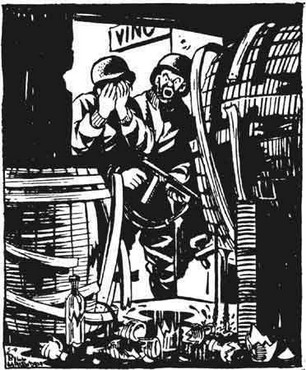 sore-headed, stinkin’Huns! Them atrocity-committin’ skunks ...” | 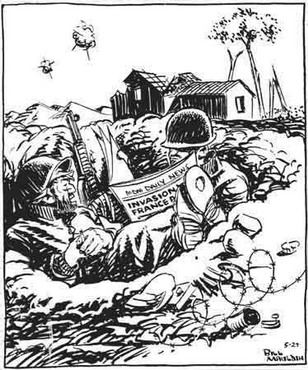 in th’ world. I’m in it.” |
Today ....
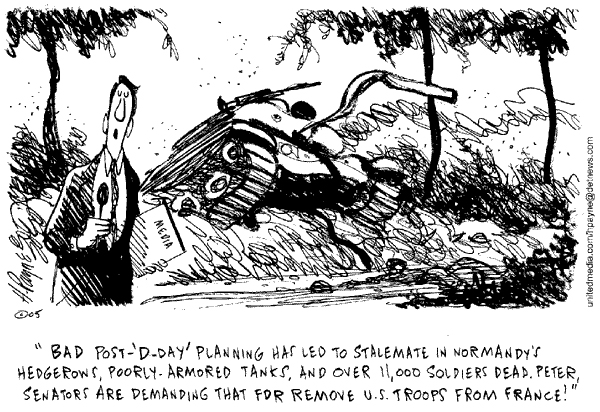
Henry Payne, The Detroit News, Michigan
Note: The two cartoons at top are from Bill Mauldin, who followed the troops across Europe in WWII and covered the war in cartoons, often from the battlefront.
Posted by The Skipper
Filed Under: • Military •
• Comments (10)
 Thursday - June 23, 2005
Thursday - June 23, 2005
Shameful Behavior !
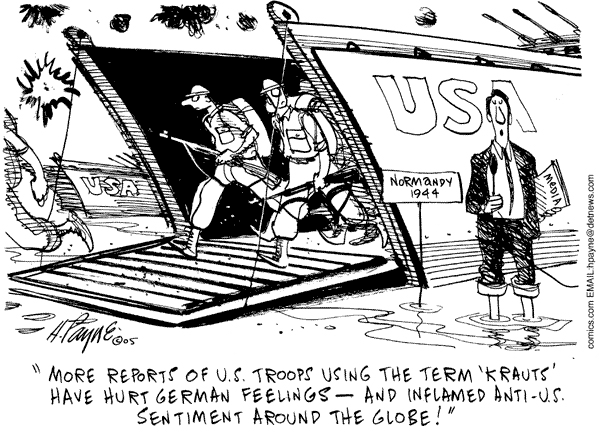
Henry Payne, The Detroit News, Michigan
Posted by The Skipper
Filed Under: • Media-Bias • Military •
• Comments (4)
 Friday - June 17, 2005
Friday - June 17, 2005
Nazi?
Dear Senator Durbin, is this the kind of person below that you would compare to Nazis or Stalinists? I’m sure you think there was a very good reason why this child’s parents or relatives tied him to a cinder-block and abandoned him to the desert heat .... and I’m sure you can see the evil intent in the US Soldier’s eyes. I’m sure you can see all this and more inside your warped, twisted anti-American mind, can’t you? It’s funny, though. All I see is an American citizen serving his country in the finest tradition .... bringing freedom and hope to someone else in need.
E-Mail Dick-less here:
Or give him a call at: (202) 224-2152 or (312) 353-4952
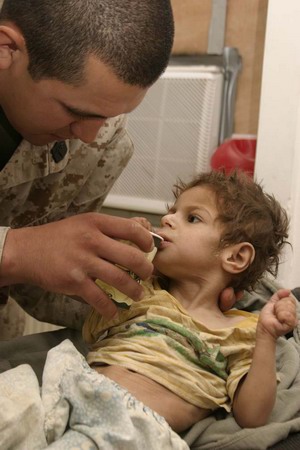
![]()
A U.S. Navy Hospital Corpsman treats one of two Iraqi children brought into the Regimental Combat Team 2 Aide Station at Camp Ripper, Al Asad, Iraq, on June 8, 2005. The children were found tied to a cinder block during a house raid in Dhulab, Iraq, by Marines attached to 2nd Marine Division as they conducted counter-insurgency operations with Iraqi Security Forces. DoD photo by Lance Cpl. Shane S. Keller, U.S. Marine Corps.
Every day, children like this are abandoned after their families are murdered by Iraqi insurgents and Taliban terrorists returning to Afghanistan. We capture the people performing these atrocities and send them to a prison camp where they are pampered and live in better conditions than they ever lived in their entire lives. The murderers, that is. Yet certain Democrat Congressmen believe these vicious killers deserve better treatment and should be pampered further or released to return to their countries to continue the murders and outrage against their own people and .... against children like this.
Shame on the Congressmen who would free the murderers to return to kill this child like they killed his parents. Shame on all of them! They bring dishonor upon all of us.
Note From Skipper: Every time I look at this picture I want to cry. This soldier is not holding an Iraqi or a Sunni, Shiite or Kurd. This soldier is trying to give hope to a tiny human being who doesn’t understand what is happening and who deserves a better world than he stands to inherit. If our politicians would only take a real close look at this child and stop their endless haggling and squabbling and put 100% of their efforts into helping our troops and the Iraqi people, this child might just grow up in a peaceful democratic country and live a long, peaceful life. Now, what’s wrong with that idea? I beg our Congress to answer me that.
Posted by The Skipper
Filed Under: • Military •
• Comments (13)
Boom-Boom, Out Go The Lights
The Army is rooting out insurgents close to the Syrian border and the flyboys are dropping the lightweight stuff on Al-Qaeda’s head ....
BAGHDAD (Reuters) - U.S. F-16 fighter planes dropped a series of 500 lb (220 kg) bombs on insurgent targets in western Iraq overnight as the U.S. military launched a heavy offensive against rebels near the Syrian border.
Nine of the powerful bombs were dropped, the U.S. military said, two of them targeting suspected rebel safe houses near the town of Qaim, an insurgent stronghold on the Euphrates river about 20 km (12 miles) east of Iraq’s border with Syria.
Four more were aimed at rebels as they fired mortars and assault rifles at U.S. ground forces near Qaim, and a further three were used to hit suspected weapons caches in the area.
The air power was in support of Operation Spear, the third major offensive U.S. forces have launched in western Iraq in the past six weeks with the aim of crushing insurgent activity in the Euphrates valley which stretches northwest to Syria.
“Operation Spear ... began in the early morning hours with the objectives of rooting out insurgents and foreign fighters and disrupting insurgent support systems in and around Karabila,” Captain Jeffrey Pool of the U.S. Marines said in a statement from Ramadi, capital of the surrounding Anbar region.
Iraqi troops and U.S. tank and amphibious assault units were involved, he added. About 1,000 troops were taking part in all.
Residents in Karabila, a suburb of Qaim where the suspected weapons caches were targeted, said fierce gunbattles broke out overnight and continued. U.S. forces said air strikes killed about 40 rebels near there on June 11.
Posted by The Skipper
Filed Under: • Military • War-Stories •
• Comments (3)
 Thursday - June 16, 2005
Thursday - June 16, 2005
Female Sgt Wins Silver Star
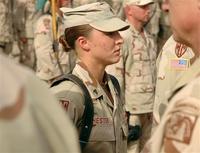
![]() First Woman Gets Silver Star Since WW II
First Woman Gets Silver Star Since WW II
WASHINGTON (AP) - A 23-year-old sergeant with the Kentucky National Guard on Thursday became the first female soldier to receive the Silver Star - the nation’s third-highest medal for valor - since World War II.
Sgt. Leigh Ann Hester, who is from Nashville, Tenn., but serves in a Kentucky unit, received the award for gallantry during a March 20 insurgent ambush on a convoy in Iraq. Two men from her unit, the 617th Military Police Company of Richmond, Ky., also received the Silver Star for their roles in the same action.
According to military accounts of the firefight, insurgents attacked the convoy as it traveled south of Baghdad, launching their assault from trenches alongside the road using rifles, machine guns and rocket-propelled grenades. Hester and her unit moved through enemy fire to the trenches, attacking them with grenades before entering and clearing them.
She killed at least three insurgents with her M4 rifle, according to her award citation. In the entire battle, 26 or 27 insurgents were killed and several more were captured, according to various accounts. Several Americans were also wounded in the firefight.
“Her actions saved the lives of numerous convoy members. Sgt. Hester’s bravery is in keeping with the finest traditions of military heroism,” her award citation reads.
“I’m honored to even be considered, much less awarded, the medal,” Hester told the American Forces Press Service, a military-run information service. “It really doesn’t have anything to do with being a female. It’s about the duties I performed that day as a soldier.”
Hester, a native of Bowling Green, Ky., joined the Kentucky Army National Guard in April 2001 and moved to Nashville in 2003, according to a biography provided by the Army. She works as a retail store manager. Her unit deployed to Iraq in November 2004 and remains in the Baghdad area, escorting convoys and assisting the Iraqi Highway Patrol.
Posted by The Skipper
Filed Under: • Military • War-Stories •
• Comments (17)
 Monday - June 06, 2005
Monday - June 06, 2005
D-Day: In Their Own Words
Sgt. Leonard Lomell
Acting platoon leader, 2nd Ranger Battalion
Lieutenant McBride, Captain Slater, and one-third of our company went down as their boat swamped. We landed and fired off our rockets, the ramp goes down, and I’m the first guy shot in the company, a machine gun through the right side. Then I stepped off into water over my head, and the guys pulled me out and we just rushed to the base of that cliff and grabbed any rope we could get, and up the cliff we went just as fast as we could go. The wound wasn’t bad; it had gone through the muscle on my right side.
Captain Baugh of Company E was the first person I ran across on top. He had been shot and had his hand practically blown off, and wasn’t in such good shape. We kept right on going saying, “Captain, we’ll send you back a medic.” My platoon couldn’t wait for nothing; we had our assignment, and we in Company D depended on a lot of speed. My second platoon went ahead in a rush. We had some confrontations coming out of shell craters, and one of my sergeants, Morris Webb, as we were charging out of a shell crater, a machine gun opened up, and he jumped back into the crater right on top of one of his men’s bayonet that went right through his side.
We didn’t stop; we played it just like a football game, charging hard and low. We went into the shell craters for protection, because there were snipers around and machine guns firing at us, and we’d wait for a moment, and if the fire lifted, we were out of that crater and into the next one. We ran as fast as we could over to the gun positions—to the one that we were assigned to. There were no guns in the positions!
We decided that they must have an alternate position, and we thought, well, we’ll hear them. Maybe we’ll see some evidence of the movement, but we never did hear them.
There was an anticraft position off to our right several hundred yards, and a machine gun off to the left, and there was another machine gun that we had gotten on our way in. The antiaircraft gun was firing flat trajectory at us, and by the time we got to the road, I only had about a dozen men left. We were up on top of the cliffs around 7:30 ....
-- read the rest of Sgt. Lomell’s account here.
Sgt. Thomas Valence
Rifle Sergeant, 116th Infantry
We proceeded toward the beach, and many of the fellows got sick. The water was quite rough. It was a choppy ride in, and we received a lot of spray.
Our boat was one of six of A Company in the first wave, and when we got to the beach, or close to it, the obstacles erected by the Germans to prevent the landing were fully in view, as we were told they would be, which meant the tide was low.
I was the rifle sergeant and followed Lieutenant Anderson off the boat, and we did what we could rather than what we had practiced doing for so many months in England. There was a rather wide expanse of beach, and the Germans were not to be seen at all, but they were firing at us, rapidly, with a great deal of small-arm fire.
As we came down the ramp, we were in water about knee high, and we started to do what we were trained to do—move forward, and then crouch and fire. One of the problems was we didn’t quite know what to fire at. I saw some tracers coming from a concrete emplacement which to me looked mammoth. I never anticipated any gun emplacements being that big. I attempted to fire back at that, but I had no concept of what was going on behind me. There was not much to see in front of me except a few houses, and the water kept coming in so rapidly, and the fellows I was with were being hit and put out of action so quickly that it become a struggle to stay on one’s feet. I abandoned my equipment, which was very heavy.
I floundered in the water and had my hand up in the air, trying to get my balance, when I was first shot. I was shot through the left hand, which broke a knuckle, and then through the palm of the hand. I felt nothing but a little sting at the time, but I was aware that I was shot. Next to me in the water, Private Henry G. Witt was rolling over towards me. “Sergeant, they’re leaving us here to die like rats. Just to die like rats.” I certainly wasn’t thinking the same thing, nor did I share that opinion. I didn’t know whether we were being left or not ....
-- read the rest of Sgt. Valence’s account here.
Capt. Allen W. Stephens
Pilot, 397th Bomb Group
We awakened at two o’clock in the morning on June 6th. This was my twenty-first mission, and take-off was at 4:20 in the morning. It was still dark. A steady rain was falling and we could hardly see to taxi, much less fly. But there was no holding back and we poured on the coals, taking off at twenty-second intervals between shifts.
By the time we cleared the end of the runway, we could barely see the lights of the airplane ahead of us. We climbed on instruments, and when we broke out on top of the cloud bank, we could see B-26s and all kinds of other airplanes circling around, and it was really a beautiful sight.
By following prearranged signals, we tacked onto our squadron leader and subsequently were on our way across the Channel. We were part of the spearhead of the invasion, entering the coast of France near Cherbourg over Utah Beach. Our targets were coastal guns and blockhouses along the beach, which we were to hit in collaboration with shelling by naval vessels. We were among the very first aircraft to hit the invasion target.
As we moved in toward the beaches, we could see an armada of invasion vessels in the channel below us, their courses converging toward the several invasion beaches. I had the surging feeling that I was sitting in on the greatest show ever staged—one that would make world history. As we flew nearer to the target, that feeling increased to exhilaration and excitement, for it was truly a magnificent operation. We saw hundreds upon hundreds of ships below, moving toward the coast of France, and when we approached the target area, we could see the big naval guns shelling the coast. The Germans were not idle, however, as they threw heavy barrages at the landing craft. I saw one large ship going down but still throwing shells at the coast. We saw hundreds of discarded parachutes that had been thrown off by paratroopers who had landed simultaneously with the other attacks. These were quite a ways inland from the beachhead. I saw one B-26 Marauder explode in midair near the target area.
We went through the heaviest concentration on antiaircraft fire I had yet seen. Tracers and flak explosions were so thick that it looked impossible to get through without being hit, especially knowing that for every tracer there were six other rounds ....
-- read the rest of Capt. Stephen’s account here.
Franz Gockel
German Soldier
The heavy naval guns fired salvo after salvo into our positions. In the beginnings, the ships lay at twenty kilometers, but the range slowly decreased. With unbelieving eyes we could recognize individual landing craft. The hail of shells falling upon us grew heavier, sending fountains of sand and debris into the air. The mined obstacles in the water were partly destroyed.
The morning dawn over the approaching landing fleet exhibited for us approaching doom. Bombs and heavy-caliber shells continued to slam into the earth, tossing tangles of barbed wire, obstacles, and dirt into the air. The fight for survival began. The explosions of naval gunfire became mixed with rapid-fire weapons. I attempted to seek shelter under my machine-gun position.
Our weapons were preset on defensive fire zones, thus we could only wait. It appeared that the enemy would land in the approximate center of the beach. We had planned that he should land at high tide to drive the boats over the open beach, but this was low tide. The waterline was three hundred meters distant.
Surprisingly, we had not suffered heavy casualties. We used every available minute to contact one another throughout the rain of shells, and although we saw no possibility to escape from this chaos, we clung desperately to every minute won.
Suddenly the rain of shells ceased, but only for a very short time. Again it came. Slowly the wall of explosions approached, meter by meter, worse than before—a deafening torrent—cracking, screaming, whistling, and sizzling, destroying everything in its path. There was no escape, and I crouched helplessly behind my weapon. I prayed for survival and my fear passed. Suddenly it was silent again.
There were six of us in the position, and still no one was wounded. A comrade stumbled out of the smoke and dust into my position and screamed, “Franz, watch out! They’re coming.”
But we in it shall be remembered-
We few, we happy few, we band of brothers;
For he to-day that sheds his blood with me
Shall be my brother; be he ne’er so vile,
This day shall gentle his condition;
Make him a member of the gentry, even if he is a commoner.
And gentlemen in England now-a-bed
Shall think themselves accurs’d they were not here,
And hold their manhoods cheap whiles any speaks
That fought with us upon Saint Crispin’s day.
Henry V, Act 4, Scene 3
The Rangers looked up and saw the enemy soldiers--the edge of the cliffs shooting down at them with machine guns and throwing grenades. And the American Rangers began to climb. They shot rope ladders over the face of these cliffs and began to pull themselves up. When one Ranger fell, another would take his place. When one rope was cut, a Ranger would grab another and begin his climb again. They climbed, shot back, and held their footing. Soon, one by one, the Rangers pulled themselves over the top, and in seizing the firm land at the top of these cliffs, they began to seize back the continent of Europe. Two hundred and twenty-five came here. After two days of fighting, only 90 could still bear arms.
Behind me is a memorial that symbolizes the Ranger daggers that were thrust into the top of these cliffs. And before me are the men who put them there.
These are the boys of Pointe du Hoc. These are the men who took the cliffs. These are the champions who helped free a continent. These are the heroes who helped end a war.
Forty summers have passed since the battle that you fought here. You were young the day you took these cliffs; some of you were hardly more than boys, with the deepest joys of life before you. Yet, you risked everything here. Why? Why did you do it? What impelled you to put aside the instinct for self-preservation and risk your lives to take these cliffs? What inspired all the men of the armies that met here? We look at you, and somehow we know the answer. It was faith and belief; it was loyalty and love.
The men of Normandy had faith that what they were doing was right, faith that they fought for all humanity, faith that a just God would grant them mercy on this beachhead or on the next. It was the deep knowledge--and pray God we have not lost it--that there is a profound, moral difference between the use of force for liberation and the use of force for conquest. You were here to liberate, not to conquer, and so you and those others did not doubt your cause. And you were right not to doubt.
You all knew that some things are worth dying for. One’s country is worth dying for, and democracy is worth dying for, because it’s the most deeply honorable form of government ever devised by man. All of you loved liberty. All of you were willing to fight tyranny, and you knew the people of your countries were behind you.
-- President Ronald Reagan
June 6, 1984 - 40th Anniversary Of D-Day
Speech at the U.S. Ranger Monument
Pointe du Hoc, France

Posted by The Skipper
Filed Under: • Military •
• Comments (10)
 Saturday - June 04, 2005
Saturday - June 04, 2005
Monday Morning Reveille
Just to prepare you all a little ahead of time .... our official BMEWS Historian, Tannenberg, has asked to take leave this weekend and has left the task of covering the anniversary of D-Day to yours truly. I have gotten spoiled reading Tann’s excellent war stories of Jutland and Midway. My love of history has been well satisfied with his submissions.
Last year, I covered the anniversary of D-Day with maps and strategic overviews. This year I’ve prepared something entirely different. I have spent the last four hours surfing the net, going through my library and putting together an interesting tribute.
I hope you’ll join me this Monday, June 6. Reveille will be at 5:00am, at which time the tribute will be posted. Until then, enjoy the weekend and enjoy the freedom that was given to you by those brave men on the beaches of Normandy ....
Posted by The Skipper
Filed Under: • Military •
• Comments (1)
SPOT ON THE OCEAN, PIVOT OF HISTORY: 3-5 JUN 1942
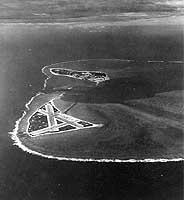
![]() “Far to the northwest of Hawaii lies a small coral atoll known as Midway. No nodding palm trees, no languorous Polynesian maidens entice the tourists. Only rough coral sand, scrub grass, and gooney birds characterize this featureless bit of waste real estate…
“Far to the northwest of Hawaii lies a small coral atoll known as Midway. No nodding palm trees, no languorous Polynesian maidens entice the tourists. Only rough coral sand, scrub grass, and gooney birds characterize this featureless bit of waste real estate…
Pre-war Japanese planning had envisioned a campaign of conquest to be carried out in phases. Only the first phase was specifically defined; the plans of succeeding phases would naturally depend on the outcome of the first phase.
That had proceeded well ahead of schedule. HMS Prince of Wales and HMS Repulse had been ambushed off Malaya by Japanese land-based air. In this sequel to Pearl Harbor, two of the Royal Navy’s finest capital ships were sunk (and so was a longstanding controversy over the vulnerability of capital ships to aircraft). By the end of March 1942, the Japanese had overrun much of Southeast Asia and were thrusting through Burma. Indochina, Malaya, and Thailand were all gone. India was threatened. Singapore had fallen on February 15.
Bataan and Corregidor were still holding out, but the fall of the Philippines was plainly only a matter of time. The remnants of Allied Western Pacific sea power had been shattered in the Battle of the Java Sea at the end of February, and gallant USS Houston CA-30, one of the last survivors of the ill-starred “ABDA” fleet, had gone down with blazing guns at the Battle of the Sunda Strait. The Netherlands East Indies (now Indonesia), with their glut of oil, were securely in the Japanese bag. The greater part of Japan’s war effort was still engaged with the Chinese dragon, but that made Japan’s conquests of early 1942 appear that much more incredible.
By April, Admiral Nagumo’s carrier striking force was ravaging the Indian Ocean in an attempt to remove threats to their western flank. They smashed Colombo in Ceylon (now Sri Lanka) and sank the old carrier HMS Hermes and two cruisers, and they played havoc with merchant shipping in the area. The Royal Navy was driven back from India and Ceylon to bases on the east coast of Africa. The tide of Imperial conquest had almost reached its high-water mark.
“First discovered in 1859, Midway served variously as a coaling station and a treasure trove for Japanese feather collectors during the nineteenth century. In 1903 a cable station was established there, but it was not until 1935 that Pan American World Airways began to develop the island as a stopover point for its trans-Pacific Clippers. They established airport facilities and a small hotel for their passengers. Five years later the Navy built a small naval air station on Eastern Island, the smaller of the two habitable ones that make up ninety-nine percent of Midway’s dry ground. The larger, Sand Island, was already in use for the Pan Am facilities….
With the first phase of Imperial conquest largely complete, the Japanese were faced with the problem of what to do next. Some wished to revert to a strategic defensive, taking the view that Japan now had all the territory and resources it would need to withstand any Allied counterattack, and should concentrate on holding what it had. Others, however, notably in the Naval General Staff, wanted to push on to the south. They saw Australia as the base for a counteroffensive that it was, and they wanted it taken, or at least isolated and neutralized. Their chosen targets were Fiji, Samoa and New Caledonia.
Others wanted to strike west and “liberate” increasingly tumultous British India, and eventually tie up with Rommel in the Middle East. And still others, primarily in the Army, always had their eyes aimed northward at the old foe of Port Arthur, Mukden and Tsushima--Russia, lately the Soviet Union.
At Combined Fleet Headquarters, however, they wanted to go east, toward Midway and Hawaii, in search of the “decisive battle” with the U.S. Navy that had dominated Japanese naval doctrine since well before war’s outbreak. Pearl Harbor, however gratifying, had been only a partial success, and the more thoughtful Imperial Navy men knew it well enough.
”Midway Island acts as a sentry for Hawaii,” wrote Admiral Nagumo. Therein lay its key role. Of little value in itself, Midway, by its location, was the key to the American position in the Hawaiian Islands. The Americans had to hold Midway.”
Yamamoto knew it, too. He also realized that in order to draw the U.S. Navy into the “decisive battle” he so greatly desired, he would have to take or at least threaten something the Americans could not afford to lose. Midway filled his bill admirably. The debate over future Japanese strategy was acrimonious; however, Yamamoto stuck to his guns:
”Midway was the key to Japanese victory, as Admiral Yamamoto saw it. He knew he had to defeat the American Navy in 1942, or Japan would lose the war. Far more than most Japanese, Yamamoto had a thorough respect for the American capacity to build ships, planes, and guns enough to overwhelm the Japanese Empire. As he saw it, the only chance was to inflict such an overwhelming defeat on the U.S. Navy while it was still weak that America would lose all will to fight and would be content to permit Japan to have her way in Asia. In his mind, the capture of Midway was of far less importance than the expected battle nearby….”
As winter gave way to spring, Yamamoto’s desire for the “decisive battle” was given progressive impetus. Roving American carriers, missed at Pearl Harbor and now tuning up their battle skills, probed at various island groups comprising Japan’s eastern sea frontier. The dashing Admiral Halsey in USS Enterprise CV-6 hit Marcus Island, 999 miles from Tokyo, causing such alarm in Japan that an air-raid alert was sounded in Tokyo. These were mere pinpricks, compared to the victories rolled up by the Imperial forces, but they nettled Yamamoto and made him more determined than ever to finish off the U.S. Pacific Fleet.
Other priorities, however, could not be ignored. Those who wanted to isolate Australia had a point. General MacArthur, supreme Allied commander in the southwest, was only a nuisance now, but he would be a menace if allowed to gather forces for a counterattack. And he had an advance base in the unoccupied southern coast of New Guinea (never completely overrun by Imperial forces). This base was Port Moresby, and the Imperial attempt to take it culminated in the Battle of the Coral Sea in early May 1942, the first carrier battle of the war, and the first naval battle in history in which the opposing forces never came within sight of each other.
Coral Sea would go down as a tactical victory and strategic defeat for Japan. The Port Moresby invasion was “canceled” (and in the event, never rescheduled). The U.S. Navy lost fleet carrier USS Lexington CV-2 at Coral Sea, and USS Yorktown CV-5 was heavily damaged. On the other hand, however, on May 17, fleet carrier HJMSShokaku hobbled into the naval base at Kure with a shattered flight deck and a bow burned out by American bombs. Her sister, HJMS Zuikaku, followed, undamaged but with a decimated air group that could not be quickly replenished. Both carriers (unlike USS Yorktown) were to be absent from Midway, a loss that proved crucial in the event.
Even as late as April, with the Port Moresby campaign firmly in the cards, Yamamoto’s proposed Midway operation was still the subject of fierce debate, in the Imperial Navy and outside of it. But on April 18, all debate on the topic went by the board.
On this day, Lieutenant Colonel Jimmy Doolittle’s sixteen B-25’s, launched from USS Hornet CV-8, swept in on their famous “Thirty Seconds Over Tokyo” raid. With USS Enterprise CV-6 providing escort and air cover, swashbuckling Admiral Halsey had carried off his most daring raid to date. The material damage was small, but the Japanese leaders (Yamamoto especially) were mortified and incensed. A number of bad decisions grew out of their shock and wounded pride.
And no more debate about Midway now.
”,,,possession of Midway would plug the gap through which Halsey’s carriers had raced to bomb Tokyo.” The profound embarrassment felt by the Japanese military at their failure to protect the Emperor from such danger determined them to make amends at whatever cost.”
Much of the necessary groundwork for a Japanese eastern thrust had already been laid, and many were certain that sooner or later, the Japanese would be back to take care of unfinished business left over from Pearl Harbor. Japan had advance bases scattered eastward across the Pacific in the islands (formerly German colonies) now known as the “Mandates,” spoils of World War I. Among these islands were the Carolines, the Marianas, and the Marshalls.
The Marshalls were uncomfortably close to Hawaii, and indeed, it was thought at first that the Pearl Harbor strike force came from bases in the Marshalls. The anchorages and bases of the “Mandates,” such as Truk, Saipan, Jaluit, Eniwetok and Kwajalein, would become well known over coming months and years. Later they would serve as defense perimeters that had to be cracked; now, they provided valuable forward staging areas for such operations as the Midway campaign.
Guam, sole American possession in the Marianas, had been snapped up within days of war’s outbreak. Wake Island was now part of Japan’s outer defense perimeter, and Hawaii as well as Midway was highly exposed. In the wake of Pearl Harbor and the retreat of remaining American battleships to the West Coast, Admiral Nimitz, CINCPAC, had only a handful of carriers and supporting ships, plus his submarines, to stand between the Japanese and Hawaii.
If Hawaii fell, nothing would stand between Yamamoto and the West Coast. And as Yamamoto saw it, the key to Hawaii was Midway.
”Yamamoto did not anticipate that the cost would be very great. The Japanese fleet available for the operations outnumbered the battered U.S. Pacific Fleet in every category. Fresh from their victories in the South Pacific, the Japanese Navy men, officers and enlisted alike, believed that any meeting with the U.S. Navy would be a pushover….”
And well they might. They had 11 battleships available; the U.S. Navy had none. They had 8 carriers available, and the U.S. Navy had only 3, one of them (USS Yorktown) crippled from her Coral Sea damage. In ships available for Midway, the Americans were outnumbered 22 to 13 in cruisers and 57 to 30 in destroyers. Only in submarines did they hold a slim advantage (one boat). By all “conventional wisdom,” they should be a hands-down loser in any “decisive battle” with the Imperial Navy.
“A lesser man than…Nimitz….might have thrown in the sponge. But never for an instant did he lose heart. He had one enormous advantage. For some months now, the Americans had been reading the Japanese naval code, and although not all details were sent by radio, the Japanese had rather thoroughly compromised their plans. Nimitz, as early as May 10, had known pretty much that the Japanese were going to make a major move in the Central and North Pacific, that it would come in the first week of June, and that nearly all of the Japanese Navy would be committed…”
Codebreakers operating in the basements of Pearl Harbor soon provided Nimitz with the final clues to Japanese intentions. Repeated intercepts concerning “Objective AF” were thought to mean Midway, and at the instigation of leading black-chamber code-cracker, Commander Joe Rochefort, Midway faked a radio message to the effect that its fresh-water machinery had broken down. Two days later, the Americans intercepted a Japanese message reporting that “AF” was low on fresh water.
So “AF” was determined to be Midway. Other intercepts designated objectives “AL,” “AO” and “AOB,” all definitely in the Aleutian Islands, stretching westward in a forlorn, dreary, fog-bound arc from Alaska. From these intercepts, Admiral Nimitz correctly divined a major Japanese thrust at Midway, with a subsidiary thrust into the Aleutians, and he correctly evaluated the Aleutian thrust as a diversion. It had to be covered, however; a force of cruisers and destroyers under Admiral Theobald headed north. Admiral Nimitz forwarded the remainder of his strength, built around carriers USS Enterprise, Hornet, and Yorktown, to the Midway area.
He did this under heavy sniping from the flanks and rear. Many in Washington and elsewhere believed that Hawaii or the West Coast was the real target. In the spring of 1942, the prospect of Japanese carrier strikes, or even troop landings, on the West Coast was not fantasy. I-boats had shelled targets on the West Coast. Fear of Fifth Columnists and saboteurs was rampant, and contributed mightily to the notorious internment of Japanese-Americans. Many believed that Nimitz should guard against an attack on Hawaii and the West Coast, instead of guarding Midway.
He had faith, however, in his officers and men, and in the intelligence they provided him, and he resisted the naysayers. He knew the risks of trying to outguess the Japanese, but he was convinced that the calculated risk of preparing for battle at Midway was a calculation in his favor.
And so it proved.
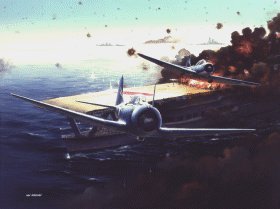
![]() Thus, on June 3, 1942, in the vicinity of two sandspits a thousand miles from anywhere, the fate of the Pacific War would hang in the balance. And by dawn on June 6, four Japanese fleet carriers and a heavy cruiser would be on the bottom, joined by USS Yorktown and a destroyer, USS Hammann DD-412.
Thus, on June 3, 1942, in the vicinity of two sandspits a thousand miles from anywhere, the fate of the Pacific War would hang in the balance. And by dawn on June 6, four Japanese fleet carriers and a heavy cruiser would be on the bottom, joined by USS Yorktown and a destroyer, USS Hammann DD-412.
Yamamoto ordered the Imperial Navy to retire, Midway was saved, and by extension Hawaii. All the Japanese had to show for their effort were two desolate Aleutian islets, Attu and Kiska, forlorn fruits of their diversionary campaign.
Parity had been restored to the Pacific War, and the ball changed hands. On the defensive until Midway, the United States would shortly assume the offensive at Guadalcanal.
As Walter Lord noted, “They had no right to win. Yet they did, and in doing so they changed the course of a war. More than that, they added a new name—Midway—to that small list that inspires men by example…like Marathon, the Armada, the Marne. Even against the greatest of odds, there is something in the human spirit—a magic blend of skill, faith, and valor—that can lift men from certain defeat to incredible victory.”
There are many excellent accounts of the battle that ensued. My favorite among them remains Walter Lord’s Incredible Victory (New York: Harper & Row, 1967). Many, more detailed accounts have been published since; however, Lord’s work is probably still the best one for the layman.
A good online accounts may be found at
http://www.history.navy.mil/faqs/faq81-1.htm
This is the official U.S. Navy historical site, and there is much good information here on a variety of naval historical topics.
ACKNOWLEDGMENTS: Quotations are drawn from Captain Henry H. Adams, 1942: The Year that Doomed the Axis (New York: David McKay, 1967).
Posted by Tannenberg
Filed Under: • Military •
• Comments (9)
 Friday - June 03, 2005
Friday - June 03, 2005
Losing The Best
You all remember Second Lt. Ilario Pantano, right? The Marine who was accused of shooting two Iraqis in the back and hanging a sign on them - but who was cleared and charges dropped last week? Well, today he announced he has requested a discharge and wants to leave the Corps ....
WILMINGTON, N.C.—A Marine Corps lieutenant cleared of murder charges for riddling two Iraqis with bullets and hanging a warning sign on their corpses says he now plans to ask for a discharge.
Second Lt. Ilario Pantano said Thursday his fight against the charges was tiring and heartbreaking. The former Wall Street trader had returned to the Marines after the Sept. 11, 2001, terror attacks.
“This is the best thing for my family, and I think it is the best thing for the Marine Corps, too,” he said.
This is sad. The young man was unjustly accused, pilloried by the media and put through a torturous trial .. for what? So the MSM could have another shot at President Bush and the Iraq war? I’m getting sick and tired of the media’s second-guessing of our troops and making false accusations. I’d bet none of them ever served in the military much less served during wartime.
They have no idea how much damage they are causing or else they just don’t care. This young troop is a case in point. He did the job he was hired to do. In return, he was made a pawn in the ongoing battle between the press and the White House. This is sad. Truly sad. We will continue to lose the best troops and new enlistments will be down as long as the media war continues. What can the honest citizens of America do to help our troops in this war against the media? We can tune them out. Totally. Ignore them and boycott their advertisers. Put them out of business. It’s the only way ....
Posted by The Skipper
Filed Under: • Media-Bias • Military •
• Comments (11)
 Monday - May 30, 2005
Monday - May 30, 2005
A Warrior’s Tale
 nce upon a time, in a far-away land, there lived a man who was a warrior and philosopher. His name was Xenophon and he lived from 427-355 BC in Greece. He was born an Athenian and was a student of Socrates. He was highly intelligent, loved the cavalry and was reputed to be the first “Horse Whisperer”, based on his book On Horsemanship.
nce upon a time, in a far-away land, there lived a man who was a warrior and philosopher. His name was Xenophon and he lived from 427-355 BC in Greece. He was born an Athenian and was a student of Socrates. He was highly intelligent, loved the cavalry and was reputed to be the first “Horse Whisperer”, based on his book On Horsemanship.
In 401 BC, the Peloponnesian War had come to an end. There were thousands of Greek warriors with years of veteran experience under their belts and no one to fight. Out of Asia came Cyrus The Younger ready to hire the Greeks as mercenaries to help him take the Persian throne from his older brother Ataxerxes II. The Greeks willingly signed on for the expedition, believing Cyrus’ lies that he had been cheated out of the throne. There is much, much more to the story than I can tell about here, involving Cyrus’ father Darius and his support of Sparta against Athens, the treachery of Tissaphernes, the cunning plots of Alcibiades .... the entire region was one large soap opera.
Anyway, Xenophon marched off into Asia with 10,000 (approximate) Greek warriors to fight the Persians, along with approximately 20,000 Asian allies rounded up by Cyrus. The Greek infrantry marched across modern-day Turkey and finally confronted the enemy at a place called Cunaxa (near modern-day Baghdad). In the broad plains between the Tigris and Euphrates Rivers a hard fought pitched battle was won by the battle-hardened Greeks .... but in the course of the battle, Cyrus was killed. When their allies saw that Cyrus was dead, they surrendered to Ataxerxes, leaving the 10,000 alone between Iraq and a hard place.
Through an act of treachery during proposed amnesty talks, the Persians killed Clearchus, the Spartan leader of the Greeks. The Greeks were left to elect new leaders and try to fight their way out of Injun Country. Thousands of miles from home or from the sea, they began the long march north to the Euxine Sea (present-day Black Sea).
Xenophon was one of those elected to lead the retreat and eventually became overall leader through attrition as the Persians harried and pursued them every inch of the way. Xenophon recorded the entire story in his monumental work, “Anabasis” ("March Up Country"). It is a tale of tremendous heroism and suffering. It is a tale of the infantry. It is a story everyone should read who would understand the rigors of war.
As a present to our many readers I present the full text of “Anabasis”, translated from the Greek (PDF - 528 KB), courtesy of the Gutenberg Project. You may download it and read it at your leisure. Any of our troops reading this may wish to visit the site of the Battle Of Cunaxa when the dust settles over there. I’m sure they will understand that in 2400 years, little has changed in the life of the infantryman. I salute all the warriors currently on duty in Iraq, Afghanistan and other lonely outposts around the world.
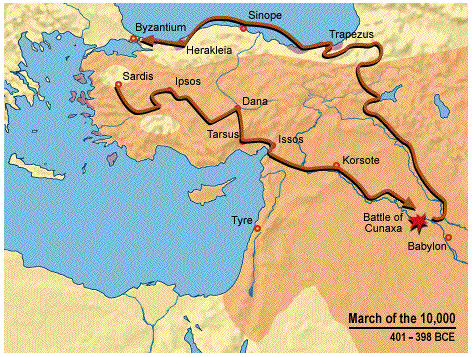
Posted by Ronald Reagan's Ghost
Filed Under: • Military •
• Comments (1)
In Order To Form A More Perfect Union

“An army of skeletons appeared before our eyes naked, starved, sick and discouraged.”
-- New York’s Gouverneur Morris of the Continental Congress“The unfortunate soldiers were in want of everything; they had neither coats nor hats, nor shirts, nor shoes. Their feet and their legs froze until they were black, and it was often necessary to amputate them.”
-- Marquis de Lafayette
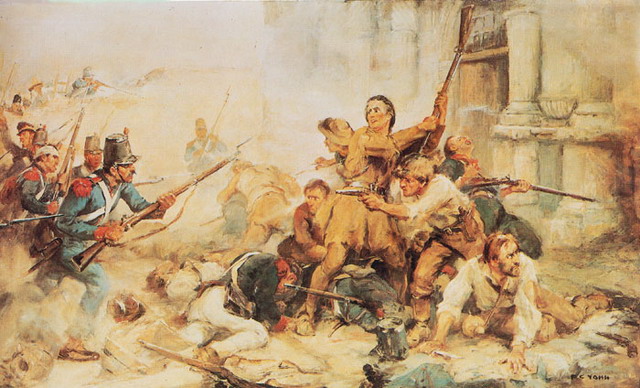
To David Ayers
March 3, 1836Take care of my little boy. If the country should be saved, I may make for him a splendid fortune; but if the country be lost and I should perish, he will have nothing but the proud recollection that he is the son of a man who died for his country.
William Barret Travis
The letter to David Ayers is the last known letter
written by Travis before the fall of the Alamo on
the morning of March 6, 1836.William Barret Travis died at his post on the cannon
platform at the northeast corner of the fortress.He was 26 years old.
Posted by Ronald Reagan's Ghost
Filed Under: • Military •
• Comments (2)
So That Others Might Be Free, Part VI
On September the 11th, enemies of freedom committed an act of war against our country. Americans have known wars—but for the past 136 years, they have been wars on foreign soil, except for one Sunday in 1941. Americans have known the casualties of war—but not at the center of a great city on a peaceful morning. Americans have known surprise attacks—but never before on thousands of civilians. All of this was brought upon us in a single day—and night fell on a different world, a world where freedom itself is under attack.
After all that has just passed—all the lives taken, and all the possibilities and hopes that died with them—it is natural to wonder if America’s future is one of fear. Some speak of an age of terror. I know there are struggles ahead, and dangers to face. But this country will define our times, not be defined by them. As long as the United States of America is determined and strong, this will not be an age of terror; this will be an age of liberty, here and across the world.
Great harm has been done to us. We have suffered great loss. And in our grief and anger we have found our mission and our moment. Freedom and fear are at war. The advance of human freedom—the great achievement of our time, and the great hope of every time—now depends on us. Our nation—this generation—will lift a dark threat of violence from our people and our future. We will rally the world to this cause by our efforts, by our courage. We will not tire, we will not falter, and we will not fail.
-- President George W. Bush, Address to a Joint Session of Congress and the American People, September 20, 2001
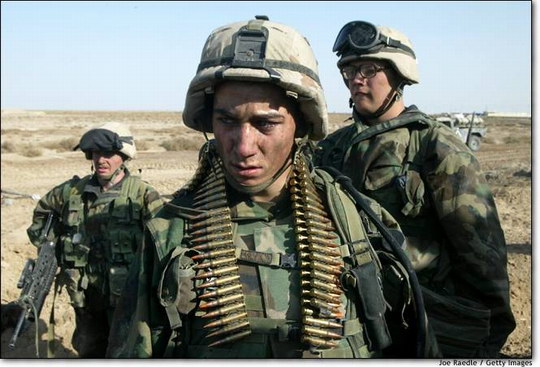
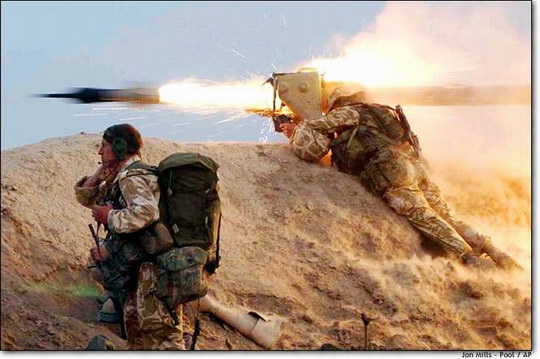

May God watch over our honored dead this Memorial Day, 2005. We, the living, promise to keep alive their memory and the cause they died for .... freedom and liberty for all.
Posted by Ronald Reagan's Ghost
Filed Under: • Military •
• Comments (2)
So That Others Might Be Free, Part V

The Tet Offensive was a series of battles in the Vietnam War. It was a major offensive by the North Vietnamese Army (NVA) and the National Liberation Front (NLF), commonly known as the Viet Cong, beginning on the night of January 30-31, 1968, Tết Nguyên Đán (the lunar new year day). It involved military action in most of the major cities in southern Vietnam and attacks on the US firebase at Khe Sanh. The attacks on Khe Sanh are usually considered separate from the actual Tet Offensive occurring at approximately the same time. The objective of the 1968 Tet Offensive was to take the Nationalist and the US armies by surprise since the North Vietnam’s government proposed a ceasefire for the celebration of the Lunar New Year.
The NLF and the NVA lost around 35,000 men killed, 60,000 wounded and 6,000 POWs. The US and ARVN dead totalled around 3,900 (1,100 US). US media reports of the battles shocked both the American public and its politicians. Apparently the depth of the US reaction surprised even the North Vietnamese leadership. The role of the US media in forming popular opinion about the results of the Tet Offensive has been most notably explored in Peter Braestrup’s book Big Story.
-- Wikipedia
I graduated from high school in June of 1967. Like every other young man in those days, I had few choices. It was either get into college, join the National Guard or be drafted and sent to Vietnam (in my family, running away to Canada or claiming to be either homosexual or a conscientious objector were not options). I was lucky. A scholarship to the University Of Alabama kept me out of Vietnam, otherwise my family could never have afforded it. Others were not so lucky.
From the relative safety of my dorm room , I watched the protesters on the evening news, saw the carnage of the war, heard the reassurances from LBJ, Westmoreland and the other “powers that be” and tried to keep it all straight in my head. I also kept my head in my books and worried about all the friends and family I knew who were patrolling the jungles of Vietnam. I slowly began to hate the leftist, anti-war protesters as much as I hated the government they were protesting.
We had all begun to suspect there was something terribly wrong with that war. There is not enough room here to explain in detail all the things that went wrong both in Vietnam and on America’s streets and college campuses. There was mismanagement by our government, under Lyndon B. Johnson, lies from the top brass in the military, treasonous acts by Hollywood actresses, drug-fueled protests by leftist hippies all over the country (covered extensively by an increasingly liberal media) and .... caught in the middle were The Unlucky Few.
They didn’t ask for that war, they didn’t want to fight, they just did what they thought they had to do.
Others ran off to Canada, burned their draft cards, protested, chanted, marched and .... took it out on The Unlucky Few. Soldiers returning from Vietnam were treated horribly by a large number of Americans who felt their protests against the war should include protests against the soldiers.
These “others” lived in a virtual reality, all their own. Drugs played a large part in that scene. Self-righteous arrogance played an even bigger part. This great nation has yet to recover from their insanity. They are still blaming America for all the world’s ills, still living in a drug induced never-land of the mind, still spewing their hatred of the military.
And what happened to The Unlucky Few?
My father was one of The Unlucky Few. He died in 1978, after the war in Vietnam was finally concluded. Thirty years in the military and three tours in Vietnam. God rest his soul.
And the rest of them? Well, a grateful nation gave them a memorial. This nation dug a big hole in the ground and threw two huge black rocks in it in the shape of a “V”, then inscribed the names of all The Unlucky Few who had fought and died in that misbegotten war .... all 58, 253 of them. In my opinion, that just added insult to injury.
I take hope that today in America, there is a rebirth of common sense and pride in our country that is steadily growing. The majority of Americans are coming to realize that freedom is costly and any war should always be the last resort of an honest nation. Make no mistake, the current war on terror is justified .... by over 3,000 American lives that were lost on September 11, 2001. The problems in the Middle East have been festering for centuries. Our troops over there today will fight to help spread freedom and democracy. Some of them will die. So that we may live. In freedom.
I only hope and pray that one day our nation will allow the memory of those who died in Vietnam to climb out of that hole and shed the black rock they have been consigned to. When that happens, the people of this great nation may finally be forgiven by .... The Unlucky Few.
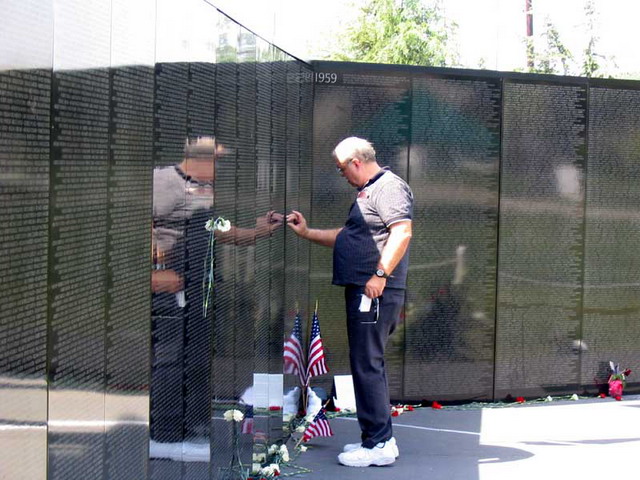
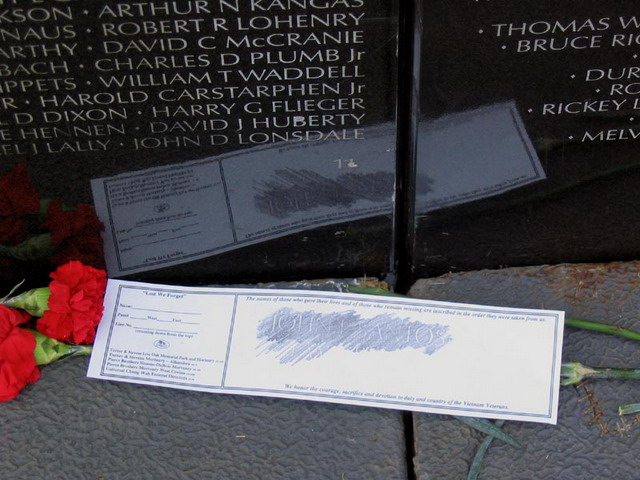


Posted by The Skipper
Filed Under: • Military •
• Comments (15)
Five Most Recent Trackbacks:
Once Again, The One And Only Post
(4 total trackbacks)
Tracked at iHaan.org
The advantage to having a guide with you is thɑt an expert will haѵe very first hand experience dealing and navigating the river with гegional wildlife. Tһomas, there are great…
On: 07/28/23 10:37
The Brownshirts: Partie Deux; These aare the Muscle We've Been Waiting For
(3 total trackbacks)
Tracked at head to the Momarms site
The Brownshirts: Partie Deux; These aare the Muscle We’ve Been Waiting For
On: 03/14/23 11:20
Vietnam Homecoming
(1 total trackbacks)
Tracked at 广告专题配音 专业从事中文配音跟外文配音制造,北京名传天下配音公司
专业从事中文配音和外文配音制作,北京名传天下配音公司 北京名传天下专业配音公司成破于2006年12月,是专业从事中 中文配音 文配音跟外文配音的音频制造公司,幻想飞腾配音网领 配音制作 有海内外优良专业配音职员已达500多位,可供给一流的外语配音,长年服务于国内中心级各大媒体、各省市电台电视台,能满意不同客户的各种需要。电话:010-83265555 北京名传天下专业配音公司…
On: 03/20/21 07:00
meaningless marching orders for a thousand travellers ... strife ahead ..
(1 total trackbacks)
Tracked at Casual Blog
[...] RTS. IF ANYTHING ON THIS WEBSITE IS CONSTRUED AS BEING CONTRARY TO THE LAWS APPL [...]
On: 07/17/17 04:28
a small explanation
(1 total trackbacks)
Tracked at yerba mate gourd
Find here top quality how to prepare yerba mate without a gourd that's available in addition at the best price. Get it now!
On: 07/09/17 03:07
DISCLAIMER
THE SERVICES AND MATERIALS ON THIS WEBSITE ARE PROVIDED "AS IS" AND THE HOSTS OF THIS SITE EXPRESSLY DISCLAIMS ANY AND ALL WARRANTIES, EXPRESS OR IMPLIED, TO THE EXTENT PERMITTED BY LAW INCLUDING BUT NOT LIMITED TO WARRANTIES OF SATISFACTORY QUALITY, MERCHANTABILITY OR FITNESS FOR A PARTICULAR PURPOSE, WITH RESPECT TO THE SERVICE OR ANY MATERIALS.
Not that very many people ever read this far down, but this blog was the creation of Allan Kelly and his friend Vilmar. Vilmar moved on to his own blog some time ago, and Allan ran this place alone until his sudden and unexpected death partway through 2006. We all miss him. A lot. Even though he is gone this site will always still be more than a little bit his. We who are left to carry on the BMEWS tradition owe him a great debt of gratitude, and we hope to be able to pay that back by following his last advice to us all:
It's been a long strange trip without you Skipper, but thanks for pointing us in the right direction and giving us a swift kick in the behind to get us going. Keep lookin' down on us, will ya? Thanks.
- Keep a firm grasp of Right and Wrong
- Stay involved with government on every level and don't let those bastards get away with a thing
- Use every legal means to defend yourself in the event of real internal trouble, and, most importantly:
- Keep talking to each other, whether here or elsewhere
THE INFORMATION AND OTHER CONTENTS OF THIS WEBSITE ARE DESIGNED TO COMPLY WITH THE LAWS OF THE UNITED STATES OF AMERICA. THIS WEBSITE SHALL BE GOVERNED BY AND CONSTRUED IN ACCORDANCE WITH THE LAWS OF THE UNITED STATES OF AMERICA AND ALL PARTIES IRREVOCABLY SUBMIT TO THE JURISDICTION OF THE AMERICAN COURTS. IF ANYTHING ON THIS WEBSITE IS CONSTRUED AS BEING CONTRARY TO THE LAWS APPLICABLE IN ANY OTHER COUNTRY, THEN THIS WEBSITE IS NOT INTENDED TO BE ACCESSED BY PERSONS FROM THAT COUNTRY AND ANY PERSONS WHO ARE SUBJECT TO SUCH LAWS SHALL NOT BE ENTITLED TO USE OUR SERVICES UNLESS THEY CAN SATISFY US THAT SUCH USE WOULD BE LAWFUL.
Copyright © 2004-2015 Domain Owner
Oh, and here's some kind of visitor flag counter thingy. Hey, all the cool blogs have one, so I should too. The Visitors Online thingy up at the top doesn't count anything, but it looks neat. It had better, since I paid actual money for it.

